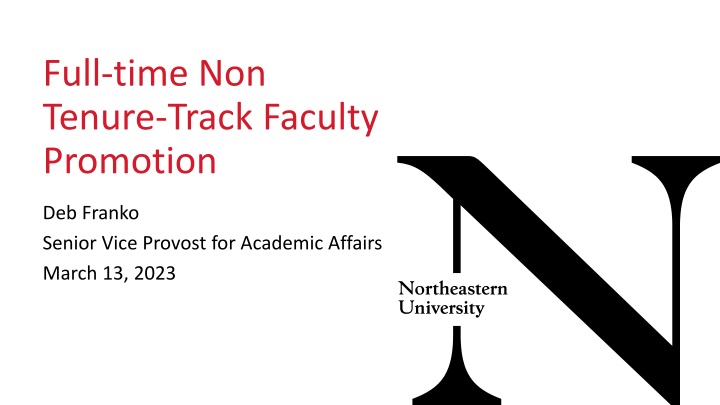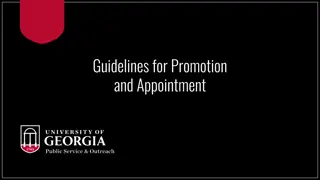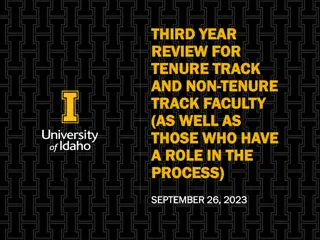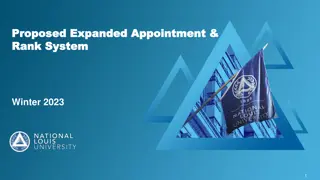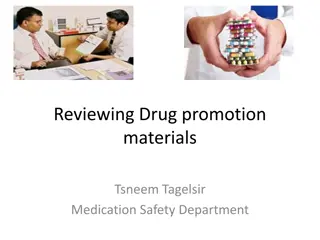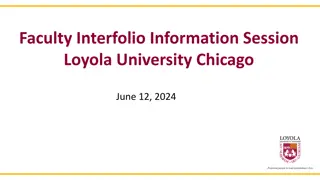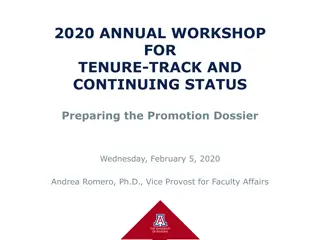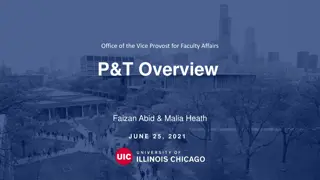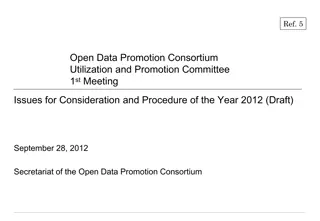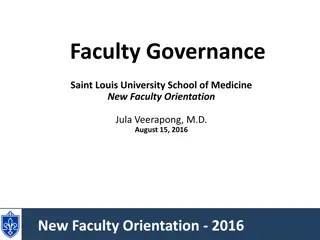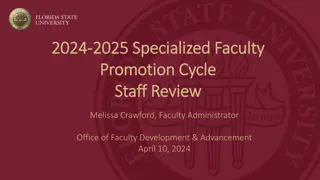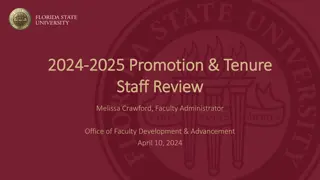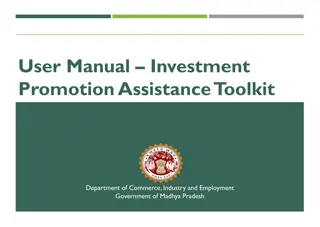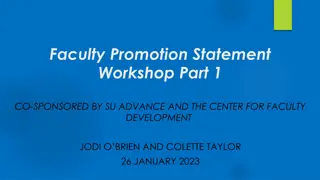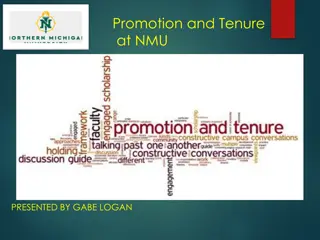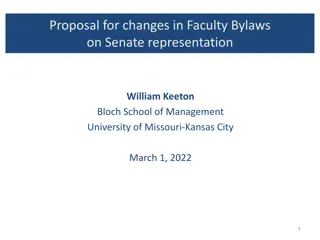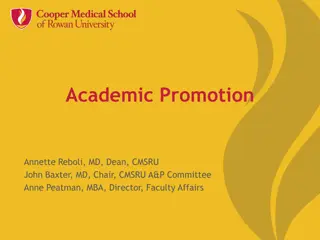FT NTT Faculty Promotion Guidelines
This document outlines the procedural requirements and institutional background related to full-time non-tenure-track (FT NTT) faculty promotion at the institution, including variations by college/unit and the review process at the university level.
Download Presentation

Please find below an Image/Link to download the presentation.
The content on the website is provided AS IS for your information and personal use only. It may not be sold, licensed, or shared on other websites without obtaining consent from the author.If you encounter any issues during the download, it is possible that the publisher has removed the file from their server.
You are allowed to download the files provided on this website for personal or commercial use, subject to the condition that they are used lawfully. All files are the property of their respective owners.
The content on the website is provided AS IS for your information and personal use only. It may not be sold, licensed, or shared on other websites without obtaining consent from the author.
E N D
Presentation Transcript
Full-time Non Tenure-Track Faculty Promotion Deb Franko Senior Vice Provost for Academic Affairs March 13, 2023
Types of FT NTT Faculty Each with different roles & responsibilities Teaching Professors Clinical Professors Academic Specialists Full-time Lecturers Professors of the Practice Co-op Coordinators Research Professors 2
Institutional Background Spring 2010: 6 FT NTT promotion dossiers reviewed and approved in Provost s office (100% success rate) Spring 2015: Teaching Professor title series implemented, built upon existing Academic Specialist ranks Spring 2017: 42 FT NTT promotion dossiers reviewed and approved in Provost s office (93% success rate) Spring 2018: 59 FT NTT promotion dossiers reviewed (95% success rate) Spring 2019: 60 FT NTT promotion dossiers reviewed (96% success rate) Spring 2022: 57 FT NTT promotion dossiers reviewed (100% success rate) 3
Procedural Requirements Minimum service of three years in present rank before October 1 dossier submission (passed by Senate April 2016 and approved by Provost Sept. 2016) Candidate makes the decision to come up; Alerts Dean s office of intention in spring of AY prior to dossier submission Dossier submitted on October 1 of your 4th year Preparation of dossier documents accomplishments in assigned responsibilities Review of dossier in unit and college according to their procedures and bylaws (Typically: Dept College Dean) Submission of dossier with all recommendations to Office of the Provost by February 15 4
Variation by college and/or unit Composition of promotion review committee varies by unit Weighting of dossier categories varies by unit and appointment category Research Professors, e.g., by contrast with Teaching Professors Service assignments vary Accreditation and/or clinical requirements relevant to some colleges (BCHS, DMSB) Co-op Coordinator dossier includes different elements External letters not required by the university but may be by the unit/rank Employer letters for co-op faculty promotion Bouve requires 3 external letters for promotion to Clinical Professor 5
Review at the university level In 2016 we implemented an Advisory Committee to the Provost on FTNTT promotions Includes associate deans of faculty affairs in the colleges and Vice Provost for Faculty Affairs Half-day meeting is held to review dossiers with advisory committee SVPAA recommends FTNTT promotions to Provost Faculty member receives notice of promotion on May 1 6
The Dossier Components of the dossier are detailed in the Model Promotion Dossier document found under Academic and Faculty Affairs on the Provost website: https://provost.northeastern.edu/academics/academic-faculty- affairs/ New in 2019: Model Promotion Dossier specific to Co-op Faculty https://provost.northeastern.edu/app/uploads/Preparation-and-Format-of-Co-op- Dossiers-5.21.19.pdf New in 2020: Model Promotion Dossier for Research Faculty https://provost.northeastern.edu/app/uploads/FINAL-FTNTT-Research-Faculty-Model- Promotion-Dossier_080120.pdf Checklist is a key document found in Model Promotion Dossier Review contents carefully 7
Dossier Materials Added by Unit and College A. Faculty Summary Sheet (Model C in Model Promotion Dossier) prepared by the Dean s Office B. Recommendations added by unit chair, departmental review committee (where applicable), college committee (where applicable), and college dean C. External Reviews added by department review committee (if applicable) 8
Candidate Dossier Materials D. Candidate s Comprehensive Dossier Curriculum Vitae E. Candidate s Statements and Supporting Evidence Teaching Statement (5 pages) and Teaching Evaluation Summary Table Professional Development and Scholarship/Creative Activity Statement (2 pages) Service Statement (1 page) F. Annual Performance Reviews G. Comprehensive List of Supporting Materials in Appendices A,B,C 9
Appendices Appendix A: Teaching Supporting Documents Full reports of TRACE evaluations Sample syllabus Teaching materials Appendix B: Professional Development and Scholarship/Creative Activity Evidence of professional development All publications Supporting Materials Appendix C: Service Activities Service supplemental materials NOTE: NO PAGE LIMIT ON APPENDICES (but be reasonable) 10
What makes a strong dossier? 1. Evidence of sustained contribution in your areas of responsibility 2. Evidence of professional development and growth in your areas of responsibility 11
Evidence of Sustained Contribution in Teaching and Learning Course materials that are current, appropriate to your field, and focused on student learning outcomes Course design and assignments at an appropriate level of student engagement and challenge Sample rubrics, examples of feedback to students Student and peer evaluations testifying to consistently responsible, responsive and challenging instruction Other evidence of student outcomes (awards, publications, graduate school admission, etc.) 12
Evidence of Professional Development and Scholarship might include, in addition to established strong classroom performance . . . Engagement with CATLR workshops and grants Wider range of courses developed and taught Curricular and pedagogical improvement and innovation Participation in and contributions to your field s pedagogical debates Scholarship, publications, conference presentations 13
Evidence of Contribution and Growth in Service Especially at full rank, may include, in addition to reliable citizenship . . . Wider program, college and/or university leadership roles with demonstrable outcomes (e.g., NTT Faculty Senate committee) Visible professional service premised on your teaching and/or professional experience and innovation Responsibility for programmatic improvement as well as continuity Development of junior colleagues Leadership roles 14
Interfolio Starting in 2019, we began utilizing a new software system for promotion review. This system, called Interfolio, is used for FTNTT faculty promotion. System for uploading as well as reviewing. Associate Deans and college key contacts can help answer questions regarding Interfolio. Accessed through myNortheastern. 15
How do I prepare for promotion? Launch conversations and planning ahead of the year in which you hope to come up Seek specific, targeted advice from your chair and your associate dean What are the strengths and weaknesses of my trajectory? What are the most important things I can do to improve my trajectory? Review ahead of time the FTNTT Model Promotion Dossier https://provost.northeastern.edu/app/uploads/FINAL-FTNTT-Model-Promotion-Dossier_080120.pdf Systematize your collection of dossier-related materials 18
Resources With counsel of your chair and associate dean, draw on resources to strengthen your trajectory CATLR workshops, one-on-one advising, grants College- and discipline-specific programming ADVANCE Office of Faculty Development offerings Full-time Faculty Development funding to support: Advanced professional training (simulation, etc.) Conference travel Training in new software to be used in classroom Research in teaching and learning 19
Questions and Discussion
